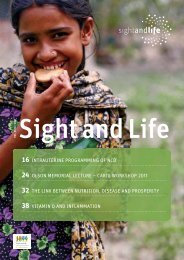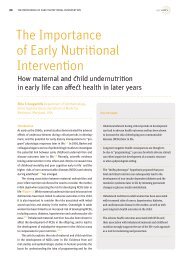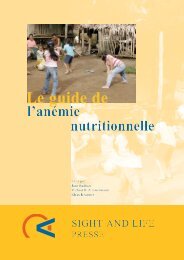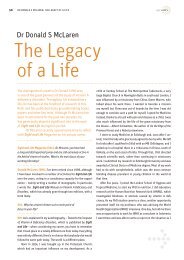Systematic Data Analysis in Qualitative Health ... - Sight and Life
Systematic Data Analysis in Qualitative Health ... - Sight and Life
Systematic Data Analysis in Qualitative Health ... - Sight and Life
Create successful ePaper yourself
Turn your PDF publications into a flip-book with our unique Google optimized e-Paper software.
SIGHT AND LIFE | VOL. 25 (2) | 2011 SYSTEMATIC DATA ANALYSIS IN QUALITATIVE HEALTH RESEARCH 53<br />
53<br />
figure 1: <strong>Data</strong> analysis spiral<br />
Procedures<br />
account<br />
Examples<br />
Represent<strong>in</strong>g,<br />
Visualiz<strong>in</strong>g<br />
Matrix, Trees,<br />
Propositions<br />
Describ<strong>in</strong>g,<br />
Classify<strong>in</strong>g,<br />
Interpret<strong>in</strong>g<br />
Context,<br />
Categories,<br />
Comparisons<br />
Read<strong>in</strong>g,<br />
Memo<strong>in</strong>g<br />
Reflect<strong>in</strong>g,<br />
Writ<strong>in</strong>g Notes,<br />
Across Questions<br />
<strong>Data</strong><br />
Manag<strong>in</strong>g<br />
Source: Creswell 3<br />
data<br />
collection<br />
(text, images)<br />
Files, Units,<br />
Organiz<strong>in</strong>g<br />
not formulated hypotheses, <strong>and</strong> is based on few (if any) preconceived<br />
notions of the f<strong>in</strong>al results. Plans for additional data<br />
collection are frequently the outcome of early cod<strong>in</strong>g with this<br />
exploratory approach.<br />
Consider, for <strong>in</strong>stance, a qualitative acceptability study of a<br />
specialized food commodity, such as a lipid-based nutrient supplement<br />
(LNS), perhaps Nutributter (Nutriset SAS, Malaunay,<br />
France). LNS conta<strong>in</strong><strong>in</strong>g energy, prote<strong>in</strong>, essential fatty acids,<br />
<strong>and</strong> micronutrients have been developed to overcome nutrient<br />
shortfalls <strong>in</strong> exist<strong>in</strong>g diets of young children 6–24 months. 10 Although<br />
Nutributter has been accepted by target populations<br />
<strong>in</strong> some sett<strong>in</strong>gs, 11 a researcher exam<strong>in</strong><strong>in</strong>g acceptability <strong>in</strong> a<br />
new sett<strong>in</strong>g us<strong>in</strong>g a qualitative approach might analyze <strong>in</strong>itial<br />
qualitative data us<strong>in</strong>g open cod<strong>in</strong>g; that is, he or she explores<br />
the textual data l<strong>in</strong>e-by-l<strong>in</strong>e for conceptualization of “emergent”<br />
themes related to beneficiary perceptions of the unfamiliar commodity.<br />
3,5 Themes from the data might emerge that are unexpected<br />
to the researcher, for example, unique cultural characteristics<br />
that directly relate to acceptability. In such a scenario,<br />
analysis us<strong>in</strong>g <strong>in</strong>ductive cod<strong>in</strong>g would be concurrent with data<br />
collection to shape future stages of the research project. New<br />
questions could be asked or additional methods added based on<br />
those emergent themes.<br />
figure 2: Visual representation of the theory<br />
of planned behavior<br />
Attitude<br />
Subjective<br />
Norms<br />
Perceived<br />
Behavioral<br />
Control<br />
Intention<br />
Behavior<br />
Source: Adapted from 12<br />
Deductive cod<strong>in</strong>g<br />
Deductive cod<strong>in</strong>g is oriented towards confirm<strong>in</strong>g or test<strong>in</strong>g the<br />
<strong>in</strong>vestigator’s preconceived terms <strong>and</strong> relationships. It is often<br />
based on a researcher’s a prior 4 (a Lat<strong>in</strong> term that refers to prior<br />
knowledge about a population) hypotheses <strong>and</strong> might utilize<br />
“prefigured” codes derived from a theoretical model or exist<strong>in</strong>g<br />
literature on the topic of <strong>in</strong>terest. 12,13 Us<strong>in</strong>g pre-determ<strong>in</strong>ed<br />
codes is popular <strong>in</strong> the health sciences – a field that utilizes<br />
many models to expla<strong>in</strong> health-seek<strong>in</strong>g behavior.<br />
As an example, consider the Theory of Planned Behavior (TPB)<br />
(Figure 2), which seeks to expla<strong>in</strong> why people perform certa<strong>in</strong><br />
actions 14,15 – for example adher<strong>in</strong>g to daily consumption of Nutributter.<br />
A researcher deductively analyz<strong>in</strong>g a textual data set<br />
would apply codes based on the TPB <strong>in</strong> relation to the major<br />
constructs of the theory: perceived behavioral control (PBC),
















